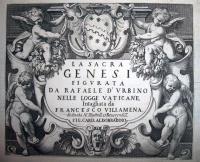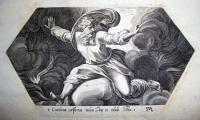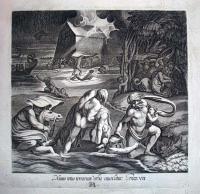A painter, architect, and supervisor of Roman archaeology research, Raphael (1483-1520), was a leading figure of the Italian High Renaissance. In 1510, he was called to Rome by Pope Julius II to create frescos for a room in the Vatican. He returned at the invitation of Leo X to decorate the walls and ceilings of the Loggie, the Papal palace. Raphael’s elaborate plans included designs for 13 ceiling vaults, 52 ceiling frescoes predominately portraying Old Testament scenes, and 28 pilaster frescoes for the walls. Much of the actual work of was ultimately accomplished by his assistants. This project has come to be known as Raphael’s Bible.
In the early years of the seventeenth century, the engraver Francesco Villamena reproduced Raphael’s biblical designs in 20 copper plate engravings (plus an engraved title page), published in at least three editions. The original prints of Princeton’s copy have been trimmed and glued to a new series of pages. The prints begin with “Confusam corporum molem Deus ex nihilo” (God creating heaven, Genesis i) and end with “Christus Dominus die tertia a mortuis resurgit” (The Resurrection, Matthew, xxviii). Also pictured here is “Diluuio totus terrarum orbis inundator” (The Deluge, Genesis vii).



What is the value of a set of engravings such as these?